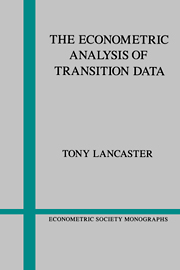Book contents
- Frontmatter
- Part I Model Building
- 1 Some Basic Results
- 2 Covariates and the Hazard Function
- 3 Parametric Families of Duration Distributions
- 4 Mixture Models
- 5 Some Important Processes
- 6 Some Structural Transition Models
- Part II Inference
- Appendix 1 The Gamma Function and Distribution
- Appendix 2 Some Properties of the Laplace Transform
- Bibliography
- Index
6 - Some Structural Transition Models
Published online by Cambridge University Press: 05 January 2013
- Frontmatter
- Part I Model Building
- 1 Some Basic Results
- 2 Covariates and the Hazard Function
- 3 Parametric Families of Duration Distributions
- 4 Mixture Models
- 5 Some Important Processes
- 6 Some Structural Transition Models
- Part II Inference
- Appendix 1 The Gamma Function and Distribution
- Appendix 2 Some Properties of the Laplace Transform
- Bibliography
- Index
Summary
Introduction
The models of chapters 1 through 5 emphasised the construction of the hazard function as the basis of model-building and thus implicitly stressed the chance character of movement between states. In economic applications as compared to applications in technology or medical science the element of choice cannot be ignored. It may be luck that an unemployed man is offered a job today, but he must choose whether or not to take it. Both choice and chance enter into the the transition process. In this chapter we shall give an account of an approach to modelling in which the choice element in each transition is emphasised. In this approach people at all times are assumed to occupy the state that they prefer, given the opportunity set that they currently face. The element of chance enters into the transition process because both the desirability of different states and the opportunities open to the economic agent vary in a partly probabilistic way over time.
When econometricians model static discrete choice among K states they find it helpful to associate with each state a utility, uj, j = 1, 2, . . . , K, depending upon the characteristics both of the state and of the choosing individual such that he chooses that state affording the greatest utility. In modelling choice among two-states then, state 2 is chosen if u2 — u1> 0 and state 1 otherwise. In modelling the stochastic process of movement between states it is natural to adapt this approach to a dynamic context in which a sequence of choices is to be made. Thus we associate with each state and each time point an instantaneous utility flow, uj (t) . The objective of the agent is no longer to choose the state with the greatest current utility flow. The problem in a dynamic context is to formulate a rule which tells the agent, given any vector of utility flows at time t, u(t), which state to occupy.
- Type
- Chapter
- Information
- The Econometric Analysis of Transition Data , pp. 122 - 142Publisher: Cambridge University PressPrint publication year: 1990
- 1
- Cited by



